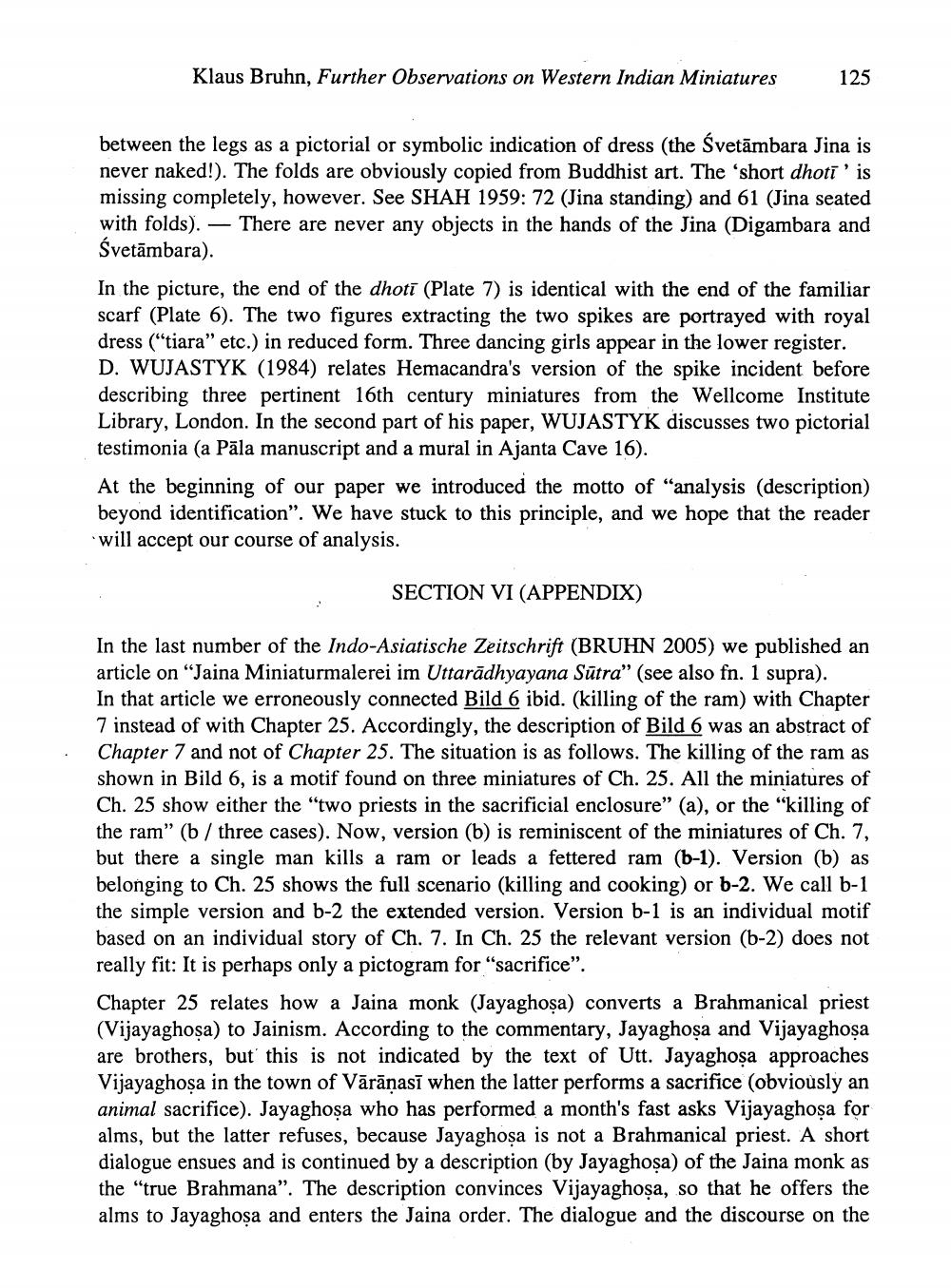________________
Klaus Bruhn, Further Observations on Western Indian Miniatures
125
between the legs as a pictorial or symbolic indication of dress (the Svetāmbara Jina is never naked!). The folds are obviously copied from Buddhist art. The 'short dhoti 'is missing completely, however. See SHAH 1959: 72 (Jina standing) and 61 (Jina seated with folds). — There are never any objects in the hands of the Jina (Digambara and Svetāmbara). In the picture, the end of the dhoti (Plate 7) is identical with the end of the familiar scarf (Plate 6). The two figures extracting the two spikes are portrayed with royal dress ("tiara" etc.) in reduced form. Three dancing girls appear in the lower register. D. WUJASTYK (1984) relates Hemacandra's version of the spike incident before describing three pertinent 16th century miniatures from the Wellcome Institute Library, London. In the second part of his paper, WUJASTYK discusses two pictorial testimonia (a Pāla manuscript and a mural in Ajanta Cave 16). At the beginning of our paper we introduced the motto of "analysis (description) beyond identification". We have stuck to this principle, and we hope that the reader will accept our course of analysis.
SECTION VI (APPENDIX)
In the last number of the Indo-Asiatische Zeitschrift (BRUHN 2005) we published an article on “Jaina Miniaturmalerei im Uttarādhyayana Sūtra" (see also fn. 1 supra). In that article we erroneously connected Bild 6 ibid. (killing of the ram) with Chapter 7 instead of with Chapter 25. Accordingly, the description of Bild 6 was an abstract of Chapter 7 and not of Chapter 25. The situation is as follows. The killing of the ram as shown in Bild 6, is a motif found on three miniatures of Ch. 25. All the miniatures of Ch. 25 show either the "two priests in the sacrificial enclosure" (a), or the "killing of the ram" (b / three cases). Now, version (b) is reminiscent of the miniatures of Ch. 7, but there a single man kills a ram or leads a fettered ram (5-1). Version (b) as belonging to Ch. 25 shows the full scenario (killing and cooking) or b-2. We call b-1 the simple version and b-2 the extended version. Version b-1 is an individual motif based on an individual story of Ch. 7. In Ch. 25 the relevant version (6-2) does not really fit: It is perhaps only a pictogram for “sacrifice". Chapter 25 relates how a Jaina monk (Jayaghosa) converts a Brahmanical priest (Vijayaghosa) to Jainism. According to the commentary, Jayaghosa and Vijayaghosa are brothers, but this is not indicated by the text of Utt. Jayaghoşa approaches Vijayaghosa in the town of Vārānasī when the latter performs a sacrifice (obviously an animal sacrifice). Jayaghosa who has performed a month's fast asks Vijayaghoşa for alms, but the latter refuses, because Jayaghosa is not a Brahmanical priest. A short dialogue ensues and is continued by a description (by Jayaghosa) of the Jaina monk as the "true Brahmana". The description convinces Vijayaghosa, so that he offers the alms to Jayaghosa and enters the Jaina order. The dialogue and the discourse on the




